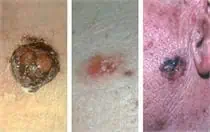
As dermatology providers, we have often been asked the question from our patients as to the risks of indoor versus outdoor tanning.
Well, the answers have recently become clear and are alarming! The rise in skin cancer rates happen to coincide with the growth of indoor tanning, which was first introduced in the U.S. in the 1970s. Just one single indoor tanning session can increase users’ chances of developing the most serious form of skin cancer, melanoma, by 20%. Each additional session during the same year increases the risk almost another 2%.
These figures are based on a recent exhaustive analysis of 27 studies by the International Research Institute in Lyons, France. Essentially, people who tan indoors are 74% more likely to develop melanoma in their lifetime. Those who started tanning before age 35 have an even higher risk of 87%, of developing Melanoma. The majority of tanning beds patrons are girls and women ages 16 to 29. They display a high level of knowledge about the risks of UV exposure, but this awareness does not alter tanning behavior.
The number of melanoma cases has tripled in the past twenty years. In 2012, melanoma has affected an estimated 76,250 people, killing 9,180 in the U.S. alone. The British Medical Journal published a study linking more than 5% of all melanomas to tanning bed use.
Heredity can play a major role in melanoma, but the disease is often be triggered by intense, intermittent sun exposure. Fair-skinned people with light hair and eye color and those who have had sunburns or tend to burn easily are at increased risk of developing melanoma. So are those who have a family history of the disease or have ever themselves had a melanoma or other skin cancer. People with unusual-colored and large-sized moles are at a higher risk. In the earliest stages, melanoma is readily treatable. Left untreated, however, it can spread to vital organs and become life-threatening. Among patients with advanced disease, just 15% survive longer than 5 years.
Further studies have shown the role of indoor tanning on non-melanoma skin cancers. Close to 171,000 (or about 3%) of non-melanoma skin cancers diagnosed each year in the U.S. are attributed to indoor tanning. A single UV tanning session increases squamous cell skin cancers (SCC) by 67% and basal cell skin cancer (BCC) by 29%. Additionally, indoor tanners under the age of 25 double their risk of SCC and increase their risk of BCC by 40%.
Skin cancer prevention is optimally about sun protection. Nonetheless, secondary prevention involves early detection. An annual head to toe skin exam by a dermatology provider is recommended by the Skin Cancer Foundation, with a monthly self-examination. Familiarize yourself with suspicious appearing lesions, new or changing moles, spots, sores, lesions or growths. When patients are diagnosed and treated at an early stage of skin cancer, almost all make a full recovery.
Remember to wear sunscreen, apply 1 oz (2 TBS) to your entire body 30 minutes before going outside. Reapply every 2 hours or after swimming or excessive sweating.
Unfortunately, despite recent efforts to educate the public and limit young peoples’ access to indoor tanning facilities, sunbathing and indoor tanning have not significantly decreased. Thirty million Americans still visit indoor tanning salons, annually. Suntans and sunburns occur from overexposure to UV radiation, and both are signs of damage to skin cells. So, let’s get the word out there.
Learn more about skin cancer, or request a skin cancer screening at Water’s Edge Dermatology.
Sources
Publication of the Skin Cancer Foundation, Revised 2012
Robbins, Perry, M.D., The Numbers Add up:Just One Tanning Session Multiplies Skin Cancer Risk., Sun and Skin News, Winter 2012, Vol. 29, No.4
ReedK., BrewerJd Lohsce Cm, et al, Demierre MF, LazovichD, et al, Karagas MR, et al, Swerdlow AJ, Weinstock. Teen Tanners, The New Face of Melanoma, Skin Cancer Foundation Journal, Vol XXX, 2012, 34-37






